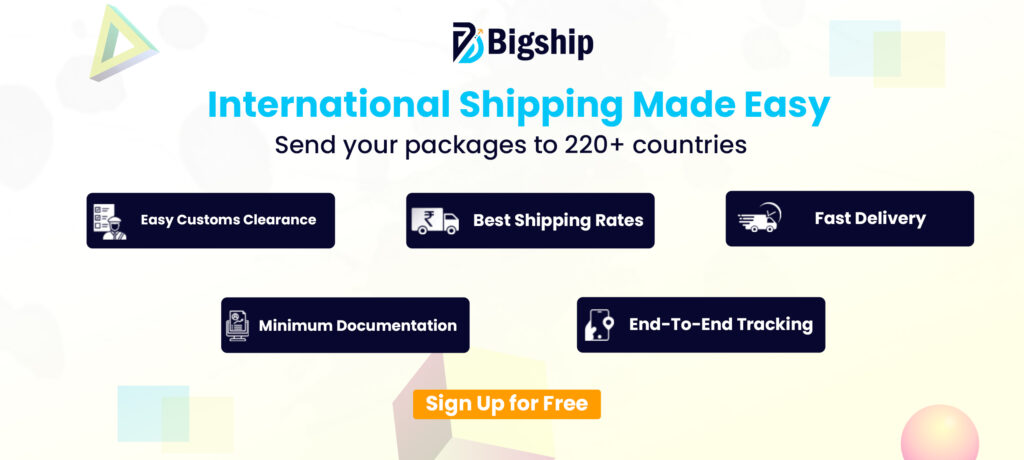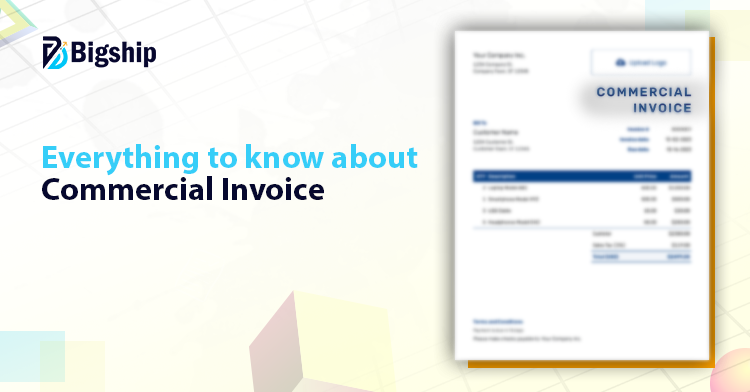If you’re sending goods abroad, a commercial invoice for international shipping is more than just a form, it’s a legal proof of sale and a must for smooth customs clearance. In this blog, we’ll break down what goes into a proper commercial invoice, common mistakes to avoid, and simple tips to get it right every time.

What is Commercial Invoice?
A commercial invoice is a simple document. You use it when you sell something to a buyer in another country. It works like a record of that sale.
Commercial invoice tells what you sold, how much you sold, and how much it’s worth. It includes the name of the seller, buyer, product details, quantity, price, and payment terms.
Customs officers check this invoice when your goods cross borders. They look at it to calculate taxes and duties. If something is wrong or missing, your shipment can get stuck.
Commercial Invoice Under Indian Laws
In India, commercial invoice is required by law. It must have complete details of your trade. That includes the buyer’s name, seller’s name, item list, quantity, price, and payment terms.
For international shipping, Indian customs accepts a combined document, that means, you can merge your invoice and packing list into one. This is allowed as per CBIC (Central Board of Indirect Taxes and Customs).
The Foreign Trade Policy also mentions it. You cannot export or import goods without certain papers. The invoice is one of them. Along with that, you need a bill of lading or airway bill and a shipping bill.
This invoice helps in many ways. It supports payment. It works as proof of the deal. It lets customs calculate duties. It keeps everything clear between you and your buyer.
So if you’re shipping something outside India, don’t skip this step. Prepare a proper commercial invoice. It saves time, avoids confusion, and keeps your shipment moving.
Key Information Required in a Commercial Invoice
Your commercial invoice for shipping should include clear and correct details. This helps with customs checks and avoids delays. Let’s look at the main points you must include.
Shipper, Receiver, and Bank Details: Start with your name and address. Also, add the buyer’s details too. Mention the contact numbers and email addresses. If you’re an exporter from India, include your GSTIN. If the buyer is outside India, mention their tax ID. Add bank details if payment will be done through bank transfer.
Goods Description: Write exactly what you are shipping. Don’t use general words. Instead of “electronics”, write “wireless headphones” or “LED monitor”. Add quantity, material, and purpose. This helps customs understand what’s inside the package.
HSN Code: Add the correct Harmonized System of Nomenclature (HS) code. Every product has a code which tells customs what your item is and what duty applies. Using the right code avoids extra charges.
Invoice Value: Clearly show the total value of your goods. If you’re covering shipping or insurance, include those costs as well. If the buyer is paying for transport, only mention the product cost.
Country of Origin: Mention where the item was made. If your product uses parts from different countries, list them. This detail helps customs apply trade rules properly.
Other Details (if needed): You may also include the air waybill number. This helps track the shipment. Add the net weight per item and the total shipment weight. These details help avoid wrong freight charges.
Difference Between Commercial Invoice and Packing List
In India, you can combine commercial invoice and packing list. However, both contain different information. Let’s find out some major point of distinctions between both.
| Commercial Invoice | Packing List |
| Commercial Invoice explains the financial details of the sale. | Packing List mentions the physical contents of the shipment. |
| It is used for customs clearance and payment processing in international trade. | It is used for logistics, stock-keeping, and checking received goods. |
| It contains invoice number, value of goods, payment terms, taxes, seller & buyer info. | It contains description of goods, weight, dimensions, number of packages. |
| It serves as proof of sale, essential for customs documentation. | It is not a legal document but vital for resolving shipment disputes. |
Mistakes to Avoid While Filling a Commercial Invoice
Avoiding common errors can save time, prevent shipment delays, and ensure smooth customs clearance during international trade. Here are some of the most common mistakes that you can avoid when filling commercial invoice.
Missing or Wrong Details: A commercial invoice with incorrect or incomplete information can cause delays or penalties. Make sure all details, like buyer and seller info, invoice number, and payment terms are accurate and complete before sending the shipment.
Using the Wrong HSN Code: HSN codes help customs decide the right tax and duty. Using an incorrect code on your commercial invoice for international shipping can result in extra costs and clearance problems. Always double-check the code before you ship.
Poor Product Description: Avoid general terms like “samples” or “parts.” Customs needs a clear and specific description, mention the product name, quantity, materials used, and how it will be used. This makes the process smoother and faster.
Declaring a Low Value on Purpose: Giving a lower value than the actual price to avoid taxes is a big mistake. It can lead to legal trouble, heavy fines, or even seizure of your goods. Always enter the true value on your commercial invoice.
Easy Tips to Create a Correct Commercial Invoice
A proper commercial invoice for shipping helps avoid delays and keeps your export process smooth. Here’s how to make sure yours is correct and compliant.
Check Everything Twice: Before sending, go through your invoice carefully. Make sure all fields are filled in correctly, especially product names, values, and HS codes. Even a small mistake can hold up your shipment at customs.
Start with a Good Template: Using a ready-made commercial invoice template saves time and ensures you include all key details. If you’re shipping from a specific country, use a format that matches local rules. For example, DHL Express offers free invoice templates through MyDHL+.
Keep a Copy for Your Records: Always save a copy of every commercial invoice you create. You might need it later for tax filing, customs checks, or if there’s any dispute with the shipment.
Ask for Expert Help if Needed: If you’re unsure about customs rules or your shipment is complicated, speak with a customs agent or shipping expert. They can help you create the right commercial invoice for international shipping and avoid problems later.
Conclusion
Creating a correct commercial invoice for international shipping is essential for smooth customs clearance, accurate tax calculation, and avoiding shipment delays. From listing the right HS code to providing a clear goods description, every detail counts. Keeping your invoices accurate and compliant not only saves time but also builds trust with global buyers.
Staying organized with your paperwork makes the process of exporting much easier. Want a hassle-free shipping experience? Sign up with Bigship and manage your shipments and invoices all in one place.
FAQs
What is commercial invoice for international shipping?
A commercial invoice is a document that provides details of the sale transaction between the buyer and seller. It’s used for customs clearance, thus, helping authorities determine duties, taxes, and whether goods comply with regulations.
What information is included in a commercial invoice?
A commercial invoice typically includes buyer and seller details, goods descriptions, quantities, values, HS codes, shipping terms, and payment instructions.





